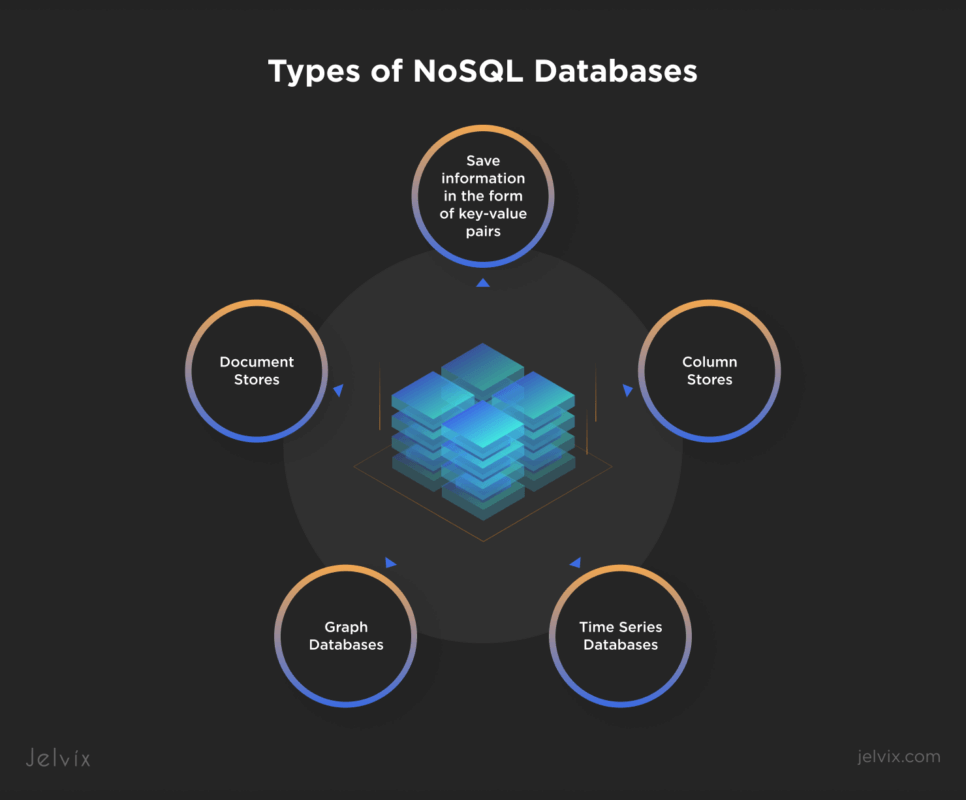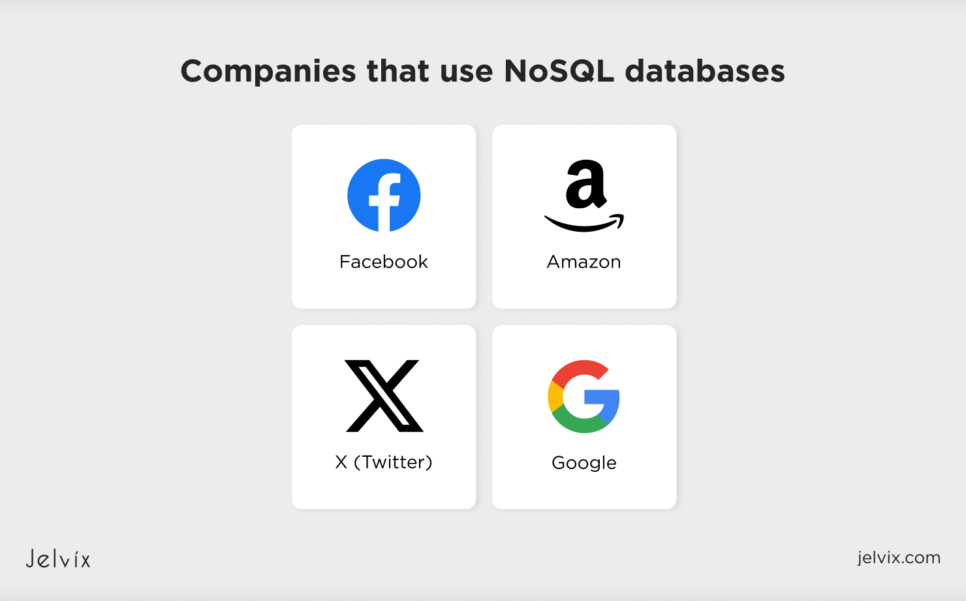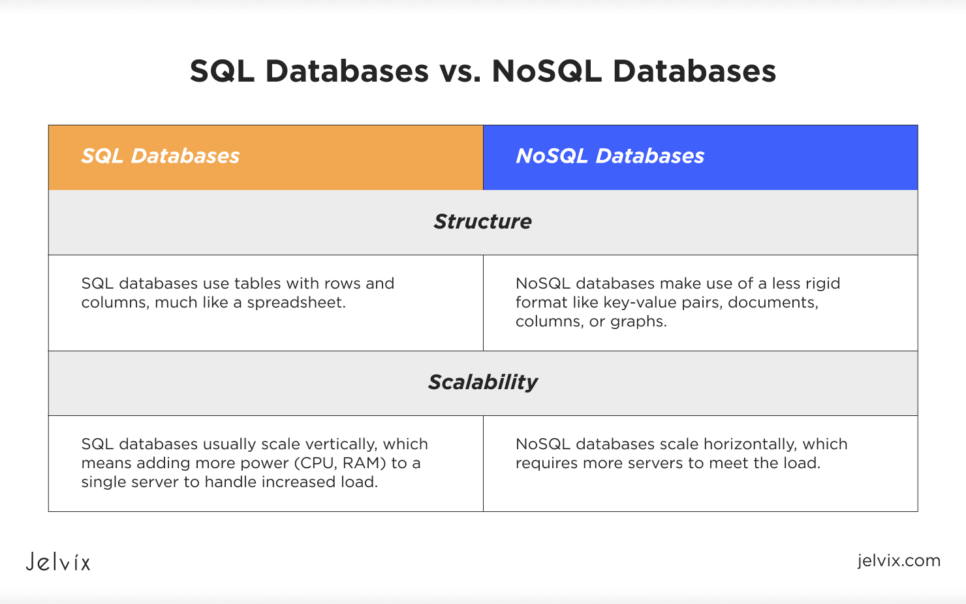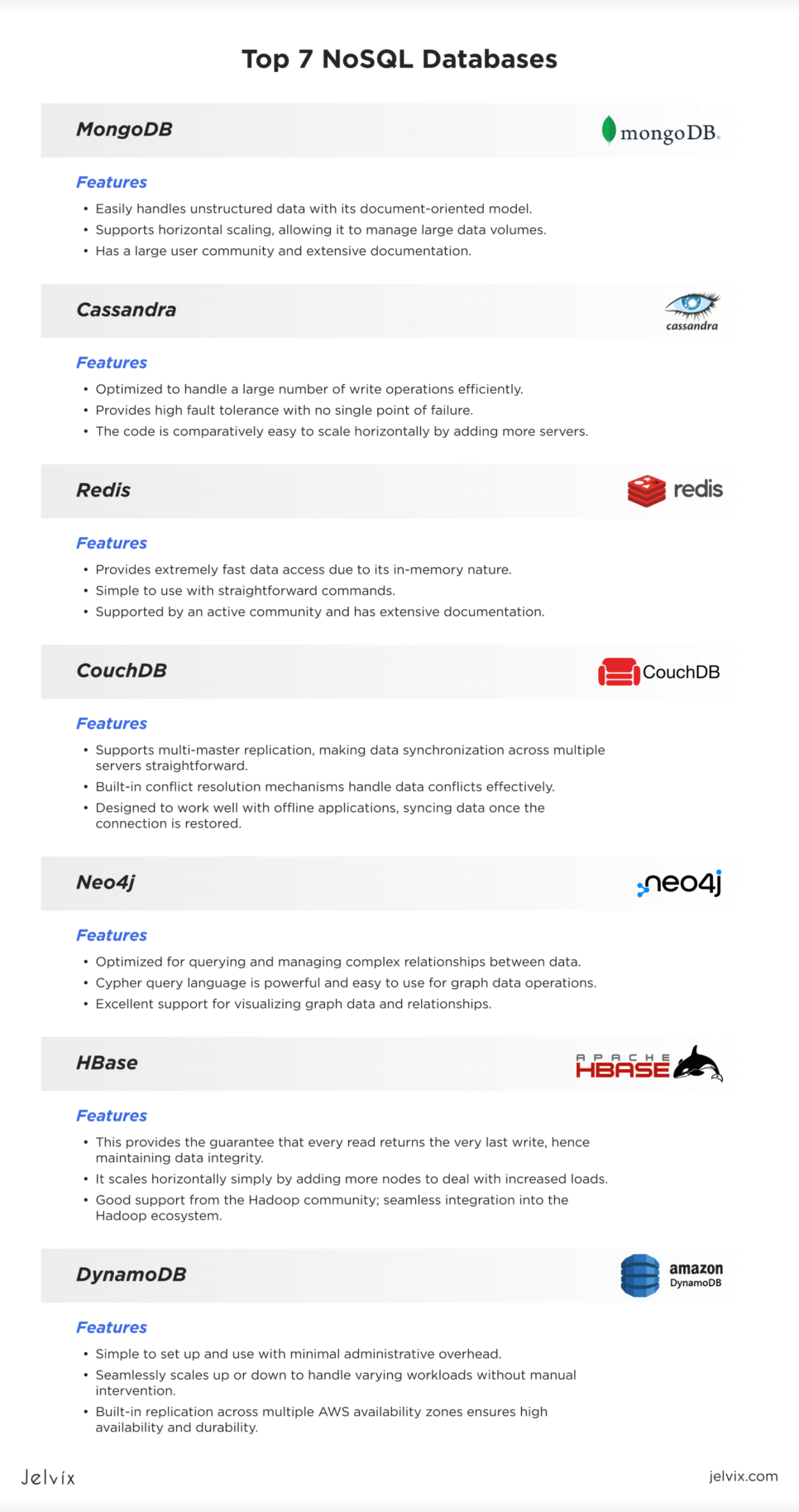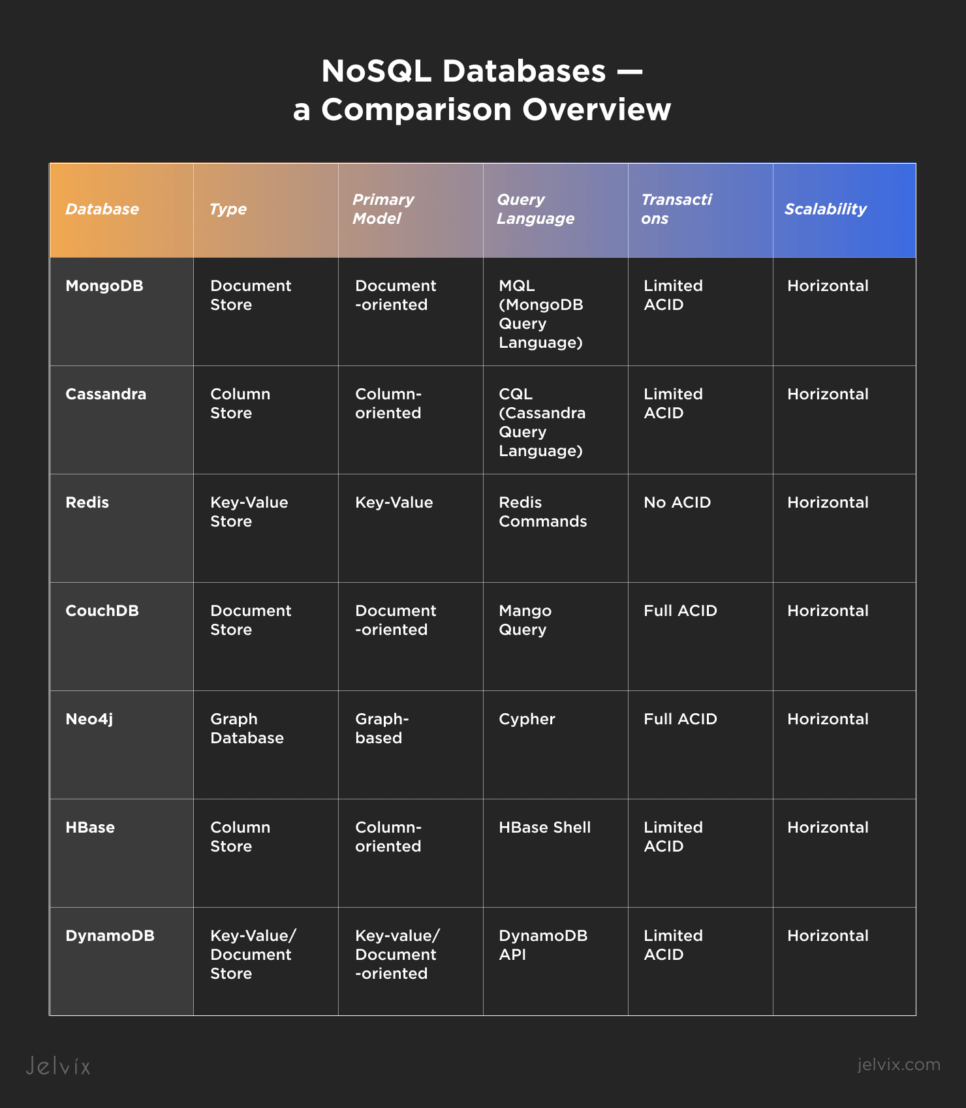NoSQL databases (DB) are crucial in today’s internet-connected world because they can efficiently handle diverse and vast amounts of data. Unlike traditional databases that use tables, NoSQL databases are flexible and can manage data spread across multiple servers, making them fast and reliable. They are widely used by major companies like Facebook, Google, and Amazon, with over 60% of companies incorporating them.
MongoDB, Cassandra, Redis, CouchDB, Neo4j, HBase, and DynamoDB are the seven most popular NoSQL databases. We will cover what makes these databases special, discussing what makes them so popular and very effective for running different data management tasks. Whether you’re a student or a developer who’s merely curious, this guide aims to help everyone along the way who wants to know about top NoSQL databases.
What is a NoSQL Database?
Relational databases (SQL) and non-relational databases (NoSQL) are the most commonly utilized types of databases. A major distinction lies in the fact that a NoSQL database operates with a dynamic schema, enabling the utilization of unstructured data.
NoSQL databases are a type of database that doesn’t use the traditional table structure like most databases. Instead, they are designed to store, manage, and retrieve data more flexibly. This makes them great for handling large amounts of unstructured data, like social media posts, emails, and big files.
Types of NoSQL Databases
There are different types of databases, each with its own way of organizing data:
- Document Stores: Store data in documents, similar to JSON files. Each data item is identified by a unique key, and the value can be anything from a string to a complex data structure.
- Save information in the form of key-value pairs. Data is typically stored in database documents, with formats such as JSON, BSON, or XML commonly used. Every document has a nested layout of key-value pairs, which may consist of lists and nested items.
- Column Stores: Also called wide-column stores, these databases organize data into columns instead of rows. This setup allows for high scalability and flexibility. Data gets grouped into column families, and each row can have a different number of columns, which is pretty handy.
- Graph Databases: These are used to store and query really connected data. Think of data as entities (nodes) and their relationships (edges). Graph databases are great at navigating these relationships and are often used for things like social networks.
- Time Series Databases: Designed to handle data sequenced by time. These databases are optimized for storing and retrieving time-stamped data points. They are ideal for applications like monitoring sensor data or tracking stock prices over time.
Many big companies use NoSQL databases because of their ability to handle large and varied data efficiently. Some of these companies include:
- Facebook: Uses Cassandra to manage large amounts of data.
- Google: Uses various NoSQL databases for different tasks.
- Amazon: Uses DynamoDB for its scalable and fast performance.
- X (Twitter): Uses NoSQL databases to manage real-time data and analytics.
These companies rely on NoSQL databases to keep their services running smoothly and handle the massive amounts of data they generate daily.
NoSQL Databases vs. SQL Databases
The key distinctions between SQL and NoSQL databases can be divided into two main categories: structure and scalability.
Structure
SQL databases use tables with rows and columns, much like a spreadsheet. Each table has a fixed schema, meaning the data structure must be defined before any data is added. This fixed schema ensures consistency and allows for complex queries and transactions.
On the other hand, NoSQL databases make use of a less rigid format like key-value pairs, documents, columns, or graphs. In the schema, you can add new data without defining its design structure. One of the reasons NoSQL databases are particularly applied to unstructured or semi-structured data management is because of the adaptability built into them.
Scalability
SQL databases usually scale vertically, which means adding more power (CPU, RAM) to a single server to handle increased load. While this can improve performance, it can also become expensive and has physical limitations.
On the contrary, NoSQL databases scale horizontally, which requires more servers to meet the load. This approach allows NoSQL databases to handle large amounts of data more efficiently and cost-effectively. Horizontal scaling makes NoSQL database solutions ideal for applications that create large amounts of data, such as:
- social media platforms;
- e-commerce sites;
- real-time analytics systems.
Therefore, NoSQL boasts some benefits:
- Flexibility. NoSQL databases can store and manage all kinds of data formats without a fixed schema. This is great for applications where the data structure can change over time.
- Performance. NoSQL databases are designed to run large volumes of read-and-write operations quickly. Hence, NoSQL solutions would form a suitable choice for high-traffic applications.
- Cost. Scaling horizontally may be less expensive than scaling vertically, which may involve purchasing more powerful—and usually more expensive—hardware.
In a nutshell, while SQL databases excel in structured data and complex queries, NoSQL databases allow flexibility, scalability, and high performance with diversified large-scale data requirements. That’s why NoSQL databases are used in many modern applications.
Let’s take a deeper look at the difference between relational vs. non-relational databases, their main principles and structure.
Things To Consider When Choosing a NoSQL Database
When selecting the best database software, it’s important to consider several factors to ensure it meets your needs. Here are key points to think about:
- Cost. The cost of a NoSQL database can vary greatly. Some of them are open source and free, while others may need licensing fees, scaling fees, or support fees. Think about your budget before investing: the total cost of ownership—hardware, software, and maintenance—included.
- Performance. Look for a NoSQL database that can handle your data volume and provide quick response times. Performance can depend on the database’s architecture, data model, and how well it handles indexing and querying.
- Scalability. One of the main distinctive features of NoSQL databases is horizontal scalability, that is, the ability to sustain increasing loads only by augmenting the number of servers. Ensure the chosen database can scale properly to handle future growth in data and traffic.
- ACID. ACID stands for Atomicity, Consistency, Isolation, and Durability. These properties are essential for transactions in traditional databases. Not all NoSQL databases provide full compliance for ACID. Therefore, consider the importance of strict transactional integrity in your application.
- High Availability vs. Reliability. It refers to the capability of the database to work correctly and predictably all the time. Choose a NoSQL database that balances these elements based on your requirements, ensuring it can tolerate faults and deliver consistent performance.
- Popularity. The popularity of any NoSQL database may be viewed as indicative of the reliability and community support one can come to expect from it. Popular databases are usually well-documented, regularly updated, and inclusive of active user communities—all this might be very helpful in troubleshooting, finding best practices, and getting help from other users.
By considering these factors, you can choose the best database software that fits your specific requirements and ensures your application’s success.
Top 7 NoSQL Databases
1. MongoDB
MongoDB is known for its flexibility and scalability. It uses a document-oriented data model, storing data in JSON-like documents, which makes it easy to handle unstructured data. This database management software is widely used in various applications, from small startups to large enterprises, because it allows for rapid development and iteration.
Pros include:
- Flexibility: Easily handles unstructured data with its document-oriented model.
- Scalability: Supports horizontal scaling, allowing it to manage large data volumes.
- Community and Support: Has a large user community and extensive documentation.
- High Performance: Provides fast read and write operations.
- Schema-less Design: No need for a predefined schema, making it adaptable to changing data requirements.
- Rich Query Language: Offers a powerful query language with support for complex queries.
- Indexing: Supports various indexing techniques for improved query performance.
- Aggregation Framework: Provides powerful tools for data aggregation and processing.
However, pay attention to the downsides:
- Complexity in Managing Relationships: Can be more complex to manage relationships compared to relational databases.
- Memory Usage: Can require significant memory for efficient operation.
- Transaction Support: Full ACID transaction support is limited to replica sets and sharded clusters.
- Data Duplication: Potential for data duplication and increased storage requirements.
- Learning Curve: May have a steeper learning curve for those used to traditional relational databases.
2. Cassandra
Cassandra is a powerful NoSQL DB designed for high availability and scalability. It uses a distributed architecture to handle large amounts of data across many servers with no single point of failure. Cassandra is highly favored for applications that require high write throughput and fault tolerance. Developed originally by Facebook, it is now widely used in industries that need to manage large-scale, real-time data across multiple data centers.
Cassandra is beneficial thanks to:
- High Write Throughput: Optimized to handle a large number of write operations efficiently.
- Fault Tolerance: Provides high fault tolerance with no single point of failure.
- Scalability: The code is comparatively easy to scale horizontally by adding more servers.
- Community and Support: It has an enormous active community, supplemented with extensive documentation.
- Distributed Architecture: The data will be divided across nodes to obtain high availability and reliability.
- Flexible Data Model: It provides for flexible schema design; it could be molded according to various use cases.
On the other hand, there are disadvantages:
- Complex Setup: Initial setup and configuration can be complex and time-consuming.
- Maintenance: Requires ongoing maintenance and monitoring to ensure optimal performance.
- Learning Curve: Steeper learning curve compared to some other NoSQL DBs.
- Query Language Limitations: Query capabilities can be limited compared to SQL databases.
- Consistency Trade-offs: May require trade-offs between consistency and availability due to its eventual consistency model.
3. Redis
Redis is an in-memory NoSQL DB, quick and simplicity-oriented. Being open source, Redis supports several data structures, like strings, hashes, lists, sets, and others. Keeping in nature highly fast speed, Redis is usually used for caching, real-time analytics, and message broker. This makes it one of the most efficient types of database for applications that require quick data access and low latency.
Redis is a good choice because of:
- Speed: Provides extremely fast data access due to its in-memory nature.
- Simplicity: Simple to use with straightforward commands.
- Active Community: Supported by an active community and has extensive documentation.
- Versatile Data Structures: Supports various data structures, making it flexible for different use cases.
- Persistence Options: Offers multiple options for data persistence to disk.
- High Availability: Supports replication and offers high availability with Redis Sentinel.
Yet, it has its cons:
- Memory Constraints: Limited by the amount of RAM available. This may become a constraint for very large datasets.
- Data Durability: Being an in-memory database, it could not be that durable compared to disk-based databases in the instance of a failure.
- Complexity in Horizontal Scaling: Horizontal scaling can be more complex compared to some other types of databases.
- Limited Query Language: This does not support complex querying capabilities like SQL databases.
- Cost: Running large datasets in memory can be expensive due to the cost of RAM.
4. CouchDB
CouchDB uses a document-oriented approach, storing data in JSON-like documents. It is designed for ease of use and reliability, with a strong focus on replication and offline-first capabilities. CouchDB’s unique feature is its multi-master replication, which allows synchronizing data across various servers and devices. This makes it a suitable database management system for applications that require distributed data and offline access.
CouchDB provides the following benefits:
- Ease of Replication: Supports multi-master replication, making data synchronization across multiple servers straightforward.
- Conflict Resolution: Built-in conflict resolution mechanisms handle data conflicts effectively.
- Offline Access: Designed to work well with offline applications, syncing data once the connection is restored.
- User-Friendly: Easy to set up and use.
- Flexible Schema: Allows for flexible and dynamic schemas, adapting to changing data structures.
Pay attention to the drawbacks:
- Slower Performance: Generally slower performance compared to other NoSQL databases like Redis and Cassandra.
- Limited Query Language: Offers limited query capabilities compared to SQL databases.
- Resource Intensive: Can be resource-intensive, especially in terms of disk usage.
- Community Size: Smaller community and ecosystem compared to some other NoSQL databases.
- Scalability: Scaling horizontally can be more complex and less efficient than other database management systems.
5. Neo4j
Neo4j specializes in graph databases, which excel at managing and querying data with complex relationships. Using the property graph model for data representation as nodes and edges, Neo4j is great for applications like social networks, recommendation systems, and fraud detection. Some of the features of this database are known for their efficient querying capabilities. Its intuitive query language, Cypher, makes it easy to explore and manipulate graph data.
You would want to choose this NoSQL because of:
- Efficient Querying of Graph Data: Optimized for querying and managing complex relationships between data.
- Intuitive Query Language: Cypher query language is powerful and easy to use for graph data operations.
- Visualizations: Excellent support for visualizing graph data and relationships.
- Flexibility: Highly flexible in modeling data with dynamic schemas.
- Active Community: Supported by an active user community and extensive documentation.
But take into account:
- Limited Scalability for Extremely Large Datasets: May face challenges in scaling horizontally for very large data sets.
- Performance Overhead: Can have performance overhead for certain types of operations compared to other NoSQL DBs.
- Complex Setup: Initial setup and configuration can be complex and require specialized knowledge.
- Cost: Can be expensive for large-scale enterprise deployments.
- Storage Requirements: May require significant storage resources, especially for large graphs with many relationships.
6. HBase
HBase is a column-oriented NoSQL database designed for fast, random access to large amounts of structured data. Built on top of the Hadoop Distributed File System (HDFS), it integrates with the Hadoop ecosystem. It is ideal for big data applications. HBase is highly scalable, supporting real-time read/write access and batch processing. This makes it perfect for applications needing quick access to large datasets, like time-series data and log analysis.
The reasons to select this NoSQL would be:
- Strong Consistency: This provides the guarantee that every read returns the very last write, hence maintaining data integrity.
- Scalability: It scales horizontally simply by adding more nodes to deal with increased loads.
- Community and Integration: Good support from the Hadoop community; seamless integration into the Hadoop ecosystem.
- Column-Oriented Storage: This stores and retrieves huge amounts of data efficiently by column instead of by row.
- Real-Time Access: It provides fast, real-time read and write access.
At the same time, HBase has some flaws:
- Complex Setup: Initial setup and configuration can be complex and time-consuming.
- Maintenance: Requires ongoing maintenance and monitoring to ensure optimal performance.
- Learning Curve: Steeper learning curve compared to some other NoSQL DBs.
- Resource Intensive: Can be resource-intensive, requiring significant hardware and operational resources.
- Latency: May experience higher latency for certain types of queries compared to in-memory databases.
7. DynamoDB
DynamoDB is a fully managed NoSQL database service from Amazon Web Services (AWS). It automatically manages data distribution and replication across multiple servers, ensuring continuous availability and durability. Its flexible data model supports both key-value and document data structures. This makes DynamoDB suitable for various applications, including web and mobile apps, IoT, and gaming.
This NoSQL DB offers:
- Ease of Use: Simple to set up and use with minimal administrative overhead.
- Scalability: Seamlessly scales up or down to handle varying workloads without manual intervention.
- High Availability: Built-in replication across multiple AWS availability zones ensures high availability and durability.
- Fully Managed: AWS manages the infrastructure, allowing developers to focus on their applications.
- Performance: Provides consistent, low-latency performance for read and write operations.
- Integration: Easily integrates with other AWS services, enhancing its functionality and utility.
And the cons are:
- Cost at High Scales: Can become expensive at large scales or with high throughput requirements.
- Limited Query Capabilities: More limited query capabilities compared with other NoSQL DBs.
- Vendor Lock-In: Tied to the AWS ecosystem, making it difficult to migrate to other platforms.
- Complex Pricing Model: Pricing is complex to estimate, especially with variable workloads.
- Partitioning Limitations: Requires careful design to avoid issues with hot partitions and optimize performance.
Comparison Overview
When it comes to choosing the right database management software, it’s all about your specific needs. Are you looking for raw performance to handle intense workloads? Or perhaps you need something that can scale effortlessly as your business grows? Maybe your top priority is ease of use, so you can focus on what matters most—your application. Each database has its strengths, so finding the perfect match depends on what you’re aiming to achieve.
Which Database is Better To Use for Your Project?
Choosing the right NoSQL database for your project depends on your needs and the features each database offers:
- MongoDB: Best for flexible schema requirements and rapid development cycles. eBay uses MongoDB for its flexible data model and scalability.
- Cassandra: Ideal for high write throughput and applications requiring high availability. Netflix uses Cassandra to manage its large-scale data needs and ensure high availability.
- Redis: Perfect for caching, session management, and scenarios needing high-speed transactions. Twitter uses Redis for caching and real-time analytics to ensure fast performance.
- CouchDB: Suitable for applications needing easy replication and offline capabilities. The BBC uses CouchDB for its offline capabilities and ease of replication across multiple devices.
- Neo4j: Optimal for complex relationship queries and graph-based data models. LinkedIn uses Neo4j to manage and query complex social graphs and relationships.
- HBase: Best for real-time analytics on large datasets integrated with Hadoop. Facebook uses HBase to store and analyze massive amounts of user data in real-time.
- DynamoDB: Great for applications requiring managed services with automatic scaling. Amazon uses DynamoDB to handle the scalability and performance needs of its e-commerce platform.
By understanding the strengths of each NoSQL database example and knowing which big companies use them, you can select the most suitable non-relational database for your project, ensuring it meets your performance, scalability, and development needs.
Conclusion
The future of NoSQL databases looks promising as they continue to evolve to meet growing data demands. We can expect more advancements in scalability and performance, making it easier to handle even larger datasets. Integration with machine learning and AI will become more common, allowing for smarter data processing and analytics. Enhanced security features will be a focus to protect sensitive data in these databases. Additionally, NoSQL databases will likely see increased adoption in new industries, further expanding their use cases.
For personalized advice on selecting the best NoSQL database for your project, contact Jelvix technical experts. Get in touch with us today to ensure your project is using the best database technology available.
Need a certain developer?
Use our talent pool to fill the expertise gap in your software development.


